20 July 2018
February 11, 1911 - February 11, 2011. First Red Devil biplane was flown in Manila with James C. Mars as its first pilot.
Pages
▼
Immigration Unveils E-Gates
20 July 2018
The Bureau of Immigration (BI) launches today its Electronic Gate System (E-Gate) project in a bid to further improve the processing of international passengers and reduce the long queues of travelers at the airports.
 BI Commissioner Jaime H. Morente said the project cost P329-million project launched initially at the Ninoy Aquino International Airport (NAIA), with the Bureau expecting to cut the standard processing time for every traveler to only about 8 to 15 seconds from the present average of 45 seconds.
BI Commissioner Jaime H. Morente said the project cost P329-million project launched initially at the Ninoy Aquino International Airport (NAIA), with the Bureau expecting to cut the standard processing time for every traveler to only about 8 to 15 seconds from the present average of 45 seconds.Morente said that aside from facilitating expeditious passenger processing, the project will also enhance the BI’s ability to pinpoint or detect travelers with derogatory records, including wanted fugitives and those who are in the Immigration Blacklist, Interpol Watchlist and Hold Departure List.
The E-Gates, an initiative of the International Air Transport Assocaition (IATA) through its Fast Travel program, are equipped with modern security features such as facial recognition, biometric scanning, bar code reading, and smart card recognition. It will first be introduced to Filipino passengers with machine readable passports. Children, senior citizens on wheelchairs and other handicapped travelers will have to be processed at the regular counters.
A total of 21 E-Gates will be installed and operational before the year ends in 5 major international airports. Eleven E-Gates will be installed at NAIA Terminals 1 and 3, while five will later operate in Mactan, three at Clark, and two in Davao.
LOOK: The new Immigration gates at work. The government has spent P321 million for 21 gates spread over NAIA T1 and 3, Cebu and Clark. pic.twitter.com/XSC0HHnEyz— Gerard de la Peña (@gerarddelapena) July 19, 2018
Alex Macheras Explains PAL A350
15 July 2018
By Alex Macheras
Mabuhay and Welcome Onboard the first @Airbus A350-900 XWB for Philippine Airlines.— Alex Macheras (@AlexInAir) July 14, 2018
Take a look at Business Class onboard — 1-2-1 configuration, newer & upgraded mood lighting, Thompson Vantage XL Seats, etc. @flyPAL | 🇵🇭 | #A350 pic.twitter.com/iYlRPu2Q8W

— Alex Macheras (@AlexInAir) July 14, 2018
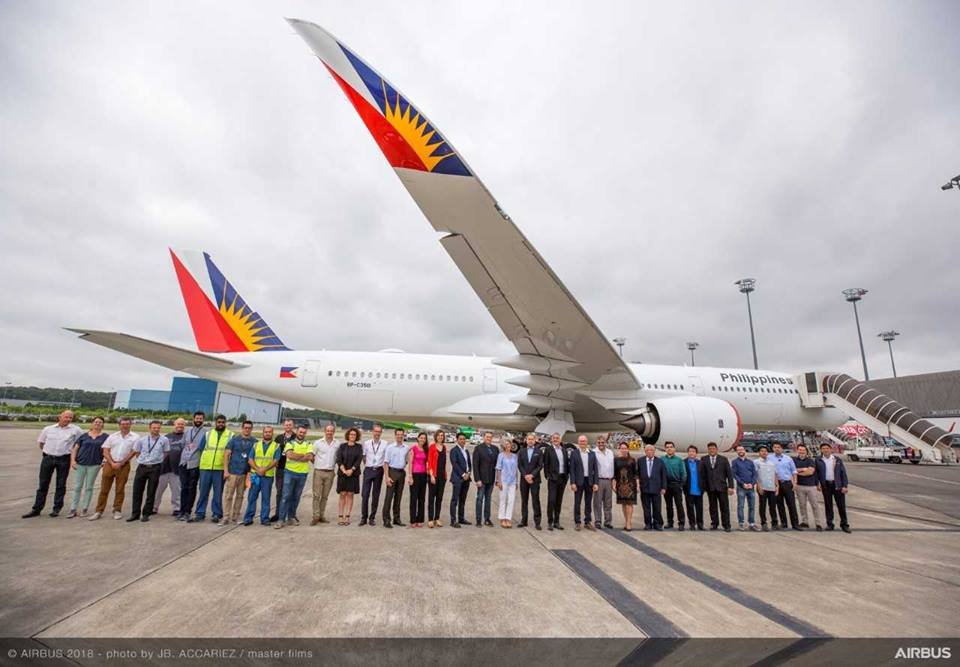
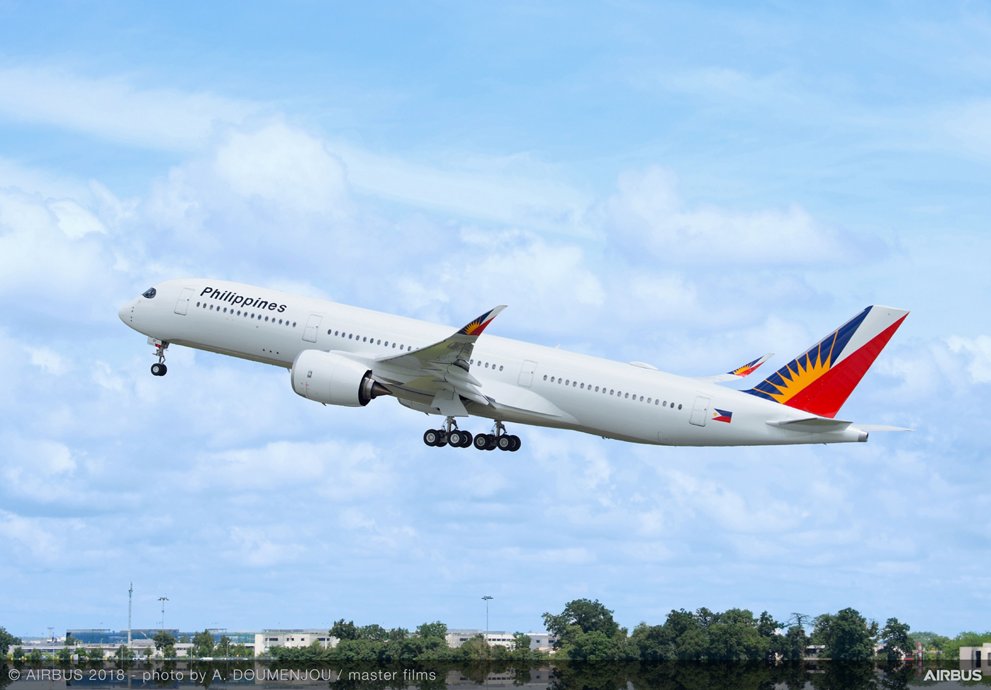 |
| PAL first A350-900 departs Toulouse for Manila. It will be arriving NAIA at 2pm Sunday. |
India Expands ASA

15 July 2018
The Philippines and India entered a new Air Services Agreement (ASA) on July 12 allowing both countries to fly 28 flights between New Delhi and Manila, in addition to three other major cities.
The new ASA allows airlines from both countries to fly more than seven flights after Cebu Pacific and Air Asia separately requested weekly pairs. Previously, only seven flights are allowed between two city pairs. Entitlements were taken by Philippine Airlines which secured seven each for New Delhi and Mumbai. Cebu Pacific intends to operate three times weekly Manila-Delhi flights beginning 2019 with A321Neo.
The renegotiated pact allows for flights to Mumbai, Kolkata, and Chennai, while India nominated Cebu, Davao, and Clark that will be flown to by Indian carriers. Philippine carriers will also be allowed unlimited flights between any Philippine gateway and 18 other destinations in India.
India and the Philippines last held air-services negotiations in 2005, allowing Filipino carriers to operate seven flights per week to Mumbai, Delhi, Kolkata and Chennai. The same entitlement was awarded to Indian carriers, which can operate seven flights per week “on each city pair” between the two countries. The first agreement was signed in 1949.
The two parties also retained 5th Freedom rights to Bangkok as a midway point for carriers of both sides, with the possibility of disembarking and taking on passengers not originating from or destined for their own territories.
The new accord makes it also possible for the operation of third-country carriers on behalf of the parties' carriers as long as the former have the route and traffic rights through their own countries granted under agreements with India and the Philippines.
A more liberal cargo provision completes the new package of air rights.
Undersecretary for Aviation Manuel Tamayo headed the Philippine Air Negotiation Panel, and was joined by Labor Undersecretary Jacinto Paras, Trade Undersecretary Rowel Barba, Foreign Affairs Asst. Secretary Leo Herrera-Lim, and Tourism Asst. Secretary Roberto Alabado III.
Philippine Airlines (PAL) used to fly to New Delhi in India via Bangkok in 2011, but suspended the route in 2013 due to poor sales.
This year, PAL will be launching direct flights to New Delhi and Mumbai using its medium haul narrow body aircraft, the Airbus 321Neo.
Fifth Freedom rights were also being reviewed by PAL from New Delhi and Mumbai to Tel Aviv, in Israel. Both Air India and El Al Airlines service the route from Delhi and Mumbai, respectively.
The PAL exploration prompted Air India to launch Tel Aviv which began its direct flight from New Delhi on March 22 using B787 preempting PAL flights. Both countries enjoy overflight rights to Saudi Arabia.
Philippines accepts India's ASEAN offer after 13 years. Bilateral Civil Aviation ties to strengthen between both countries. pic.twitter.com/bn4tHWO8KB— Ministry of Civil Aviation (@MoCA_GoI) July 14, 2018
PAL Accepts A350
14 July 2018

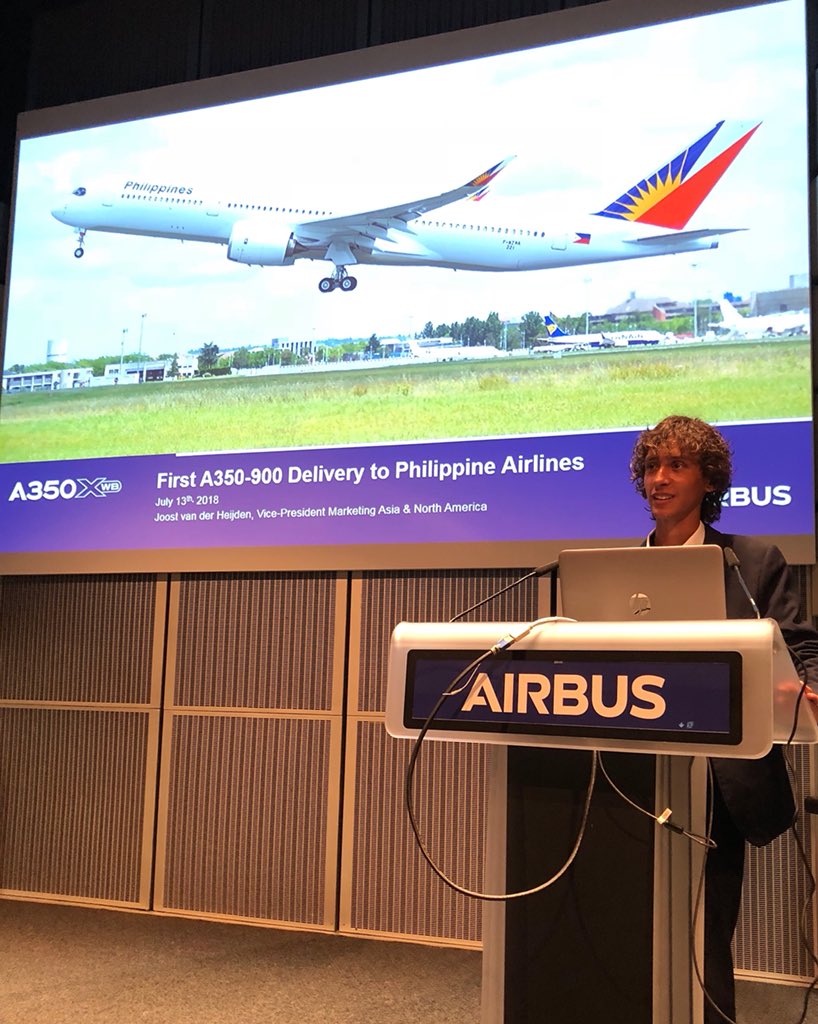 Pre-delivery ceremony of Philippine Airlines A350-900 at Toulouse, France.
Pre-delivery ceremony of Philippine Airlines A350-900 at Toulouse, France.
Toulouse - The airline delegation led by PAL Chief Executive Officer Lucio Tan is set to receive today the carrier's first Airbus A350.
The ultra-modern aircraft which will have a three-class configuration (Business Class, Premium Economy and Regular Economy) will be deployed on long-haul routes to Europe and the North American East Coast. PAL will fly the plane tomorrow to Manila.
PAL officially ordered six A350-900 aircraft, with option for another six in February of 2016, officially announced at Singapore Airshow. Purchase Agreement was signed by PAL President & Chief Operating Officer Jaime J. Bautista and Airbus President & Chief Executive Officer Fabrice Bregier.

 Pre-delivery ceremony of Philippine Airlines A350-900 at Toulouse, France.
Pre-delivery ceremony of Philippine Airlines A350-900 at Toulouse, France.Toulouse - The airline delegation led by PAL Chief Executive Officer Lucio Tan is set to receive today the carrier's first Airbus A350.
The ultra-modern aircraft which will have a three-class configuration (Business Class, Premium Economy and Regular Economy) will be deployed on long-haul routes to Europe and the North American East Coast. PAL will fly the plane tomorrow to Manila.
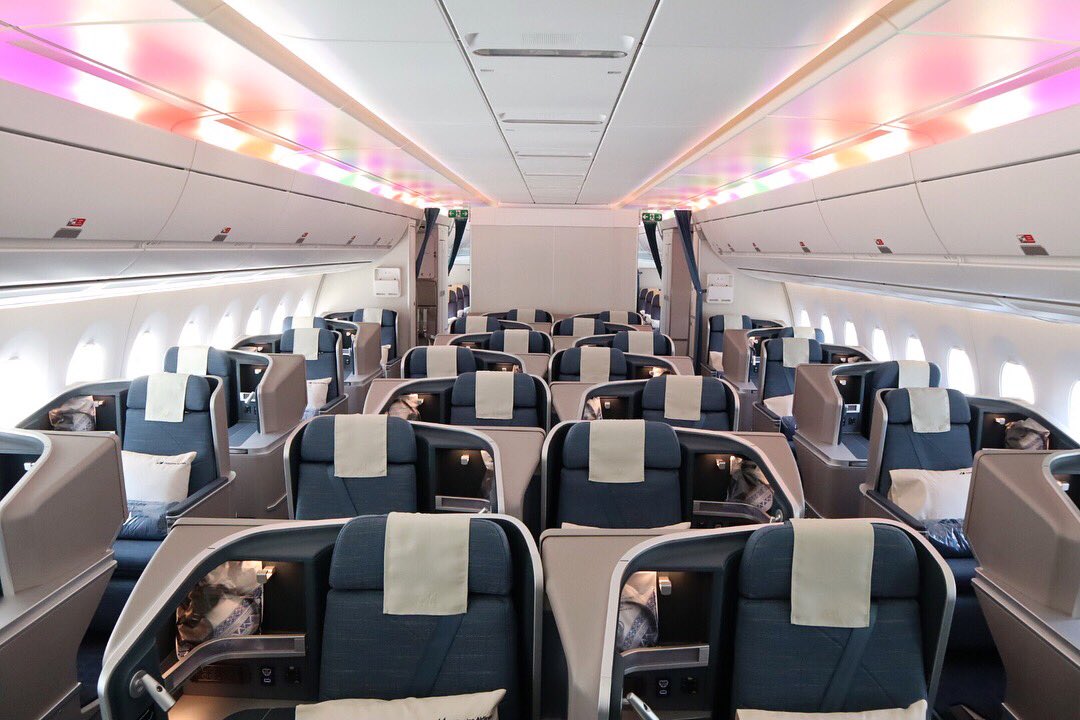 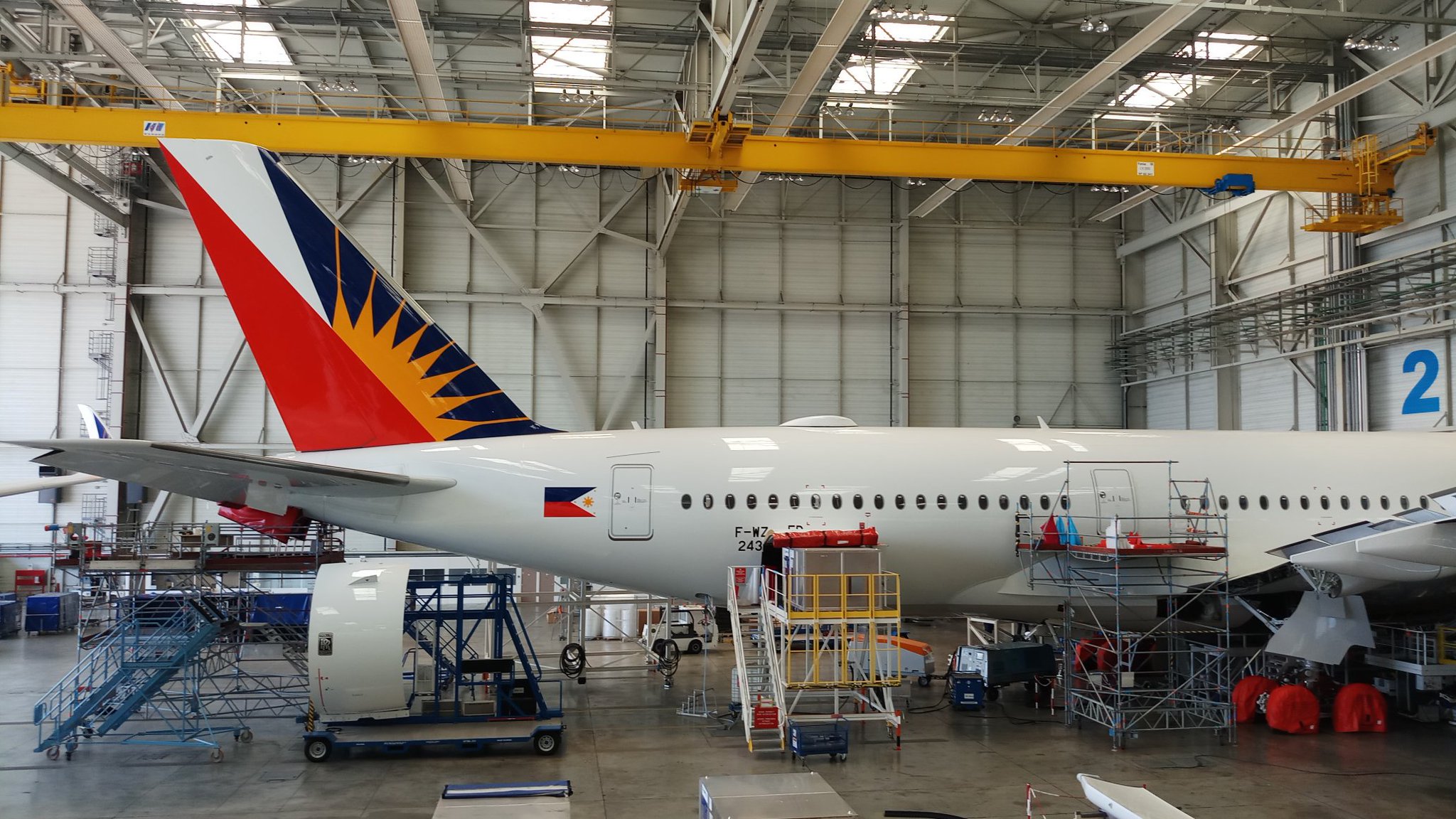 |
| First view of RP-C3504 (cn.236), PAL's 3rd A350-900 for delivery in September |
Spain Agrees 5th Freedom To Israel
Clears PAL Path To Spain and Israel

13 July 2018
The Philippines and Spain have signed an amended air transport agreement (ASA) which allows fifth freedom traffic for both countries.
Under the agreement, each of the parties may designate as many airlines as it wishes to operate both passenger and cargo operations. The Routes Chart is totally open and flexible, allowing airlines to freely select points located in the territory of the other party to operate with third and fourth freedom rights (possibility of embarking or disembarking passengers and cargo whose journey can only have origin or destination in the two countries).
In addition, for intermediate points and points beyond, they may provide their services under the fifth freedom regime (possibility of embarking or disembarking passengers and cargo whose journey has its origin or destination in third countries).
Likewise, the code-sharing operation is facilitated so that they can sign agreements of this type with companies from other countries to carry out flights between Spain and the Philippines.
“This agreement is another step to strengthen the connectivity of our country, thus facilitating the projection of Spain in the international context”, the government regulator said.
In 2009, the Philippines and Spain have sealed a new Air Services Agreement (ASA), fielding 28 weekly flights for each country, said the Civil Aeronautics Board (CAB).
From Manila to Madrid and Barcelona, there were seven flights per week awarded to the Philippines.
To Madrid and Barcelona from Clark’s International Airport, 14 weekly flights were allocated.
Other points in the country, except Manila and Clark, were allotted seven flights in a week. The same goes for Spain, in which daily flights were also made available except for Madrid and Barcelona.
The ASA were not however enough to entice airlines to field flights between two end points citing inadequate traffic. There are however multiple airlines in the gulf region and Turkey providing one stop service to the Philippines.
Philippine Ambassador to Spain Philippe J. Lhuillier and Spanish Minister of Public Work and Transport José Luis Ábalos signed the updated agreement in Madrid on June 12, 2018.
Philippine Airlines(PAL) plans to introduce the route in 2019 with Airbus A340-300 aircraft. PAL intends to fly the route via intermediate points in Tel Aviv which recently was granted overflight rights, together with India, to Israel over Saudi Arabian airspace.
The government earlier secured Fifth Freedom rights to Israel in November 2013 for beyond points in India and Spain but only now did the latter allowed amendments to its air bilateral allowing PAL to finally fly the route to Spain.
Under the new agreement with Israel, the designated airlines of each country are entitled to a total of 21 flights a week, between any points in the Philippines and Israel.
CAB official added that, “We also agreed on three fifth-freedom flights per week on one intermediate point in Mumbai and one beyond point in Madrid.”

13 July 2018
The Philippines and Spain have signed an amended air transport agreement (ASA) which allows fifth freedom traffic for both countries.
Under the agreement, each of the parties may designate as many airlines as it wishes to operate both passenger and cargo operations. The Routes Chart is totally open and flexible, allowing airlines to freely select points located in the territory of the other party to operate with third and fourth freedom rights (possibility of embarking or disembarking passengers and cargo whose journey can only have origin or destination in the two countries).
In addition, for intermediate points and points beyond, they may provide their services under the fifth freedom regime (possibility of embarking or disembarking passengers and cargo whose journey has its origin or destination in third countries).
Likewise, the code-sharing operation is facilitated so that they can sign agreements of this type with companies from other countries to carry out flights between Spain and the Philippines.
“This agreement is another step to strengthen the connectivity of our country, thus facilitating the projection of Spain in the international context”, the government regulator said.
In 2009, the Philippines and Spain have sealed a new Air Services Agreement (ASA), fielding 28 weekly flights for each country, said the Civil Aeronautics Board (CAB).
From Manila to Madrid and Barcelona, there were seven flights per week awarded to the Philippines.
To Madrid and Barcelona from Clark’s International Airport, 14 weekly flights were allocated.
Other points in the country, except Manila and Clark, were allotted seven flights in a week. The same goes for Spain, in which daily flights were also made available except for Madrid and Barcelona.
The ASA were not however enough to entice airlines to field flights between two end points citing inadequate traffic. There are however multiple airlines in the gulf region and Turkey providing one stop service to the Philippines.
Philippine Ambassador to Spain Philippe J. Lhuillier and Spanish Minister of Public Work and Transport José Luis Ábalos signed the updated agreement in Madrid on June 12, 2018.
Philippine Airlines(PAL) plans to introduce the route in 2019 with Airbus A340-300 aircraft. PAL intends to fly the route via intermediate points in Tel Aviv which recently was granted overflight rights, together with India, to Israel over Saudi Arabian airspace.
The government earlier secured Fifth Freedom rights to Israel in November 2013 for beyond points in India and Spain but only now did the latter allowed amendments to its air bilateral allowing PAL to finally fly the route to Spain.
Under the new agreement with Israel, the designated airlines of each country are entitled to a total of 21 flights a week, between any points in the Philippines and Israel.
CAB official added that, “We also agreed on three fifth-freedom flights per week on one intermediate point in Mumbai and one beyond point in Madrid.”
PAL A321Neo Commences 2nd Longest Flight In the World
11 July 2018
Calayan Airport Takes Shape
6 July 2018
Calayan Airport Project is rising this year as it take shape in Barangay Dadao, Calayan Island of the Babuyan Islands chain beginning the fourth quarter of 2018.
The ₱241.43 million airport Project is the first airport to be constructed under President Duterte's Build, Build, Build Program implemented by the Transport Department (DOTr) and Department of Tourism (DOT) .
Initial funding for project implementation was approved by Congress in 2017 where ₱10 million was allocated by DOTr for ground clearing, runway preparation and concreting to the first 100 meters x18 meters of the runway. The land for the airport and the airstrip was earlier bought by DOT and developed for tourism and general aviation flights.
The Class 3 facility (community airport) when fully completed will boast a 1.2 kilometer runway x18 meters in width, 10,000sqm. apron, and Passenger Terminal building capable of handling 150 passengers. It is capable of servicing as big as DHC-Q400s and ATR72-600 turboprop plane although the airport is primarily geared to service smaller general aviation aircraft.
The airport project is expected to be completed in 2027. The 300 meter airstrip however will be made operational by 2020.
CEB Sells Ground handling Business

5 July 2018
Parent Company CEBU AIR, Inc., the listed operator of Cebu Pacific, said it sold its majority stake in its ground-handling service business., the Company Announced Monday.
Cebu Air said it has sold 60% of its shares in 1Aviation Ground handling Services Corp. to the Philippine Airport Ground Support Solutions, Inc. (PAGSS), a company led by Jefferson G. Cheng.
Cebu Pacific had previously tapped MIASCOR Ground Handling Corp. for Ground handling Services at the Ninoy Aquino International Airport (NAIA) before Manila International Airport Authority (MIAA) revoked the contract of MIASCOR after several reports of luggage theft involving the latter’s employees.
On February 2018, the Company incorporated 1Aviation Groundhandling Services Corporation to perform ground handling operations at Ninoy Aquino International Airport (NAIA) in partnership with Mr. Cheng's Philippine Airport Ground Support Solutions, Inc. (PAGSS), which license to operate was subsequently approved in March. MIAA’s contract with MIASCOR ended on April 21.
PAGSS is also a ground-handling service company based at the Ninoy Aquino International Airport (NAIA). It currently works with several airlines, such as China Airlines, Turkish Airlines, Cathay Pacific, EVA Air, Singapore Airlines and Etihad.
The sale absorbs 1Aviation operation into PAGSS divesting Cebu Air interest in ground handling operations.
CEB Ventures To Cargo Business
4 July 2018
Philippine LCC Cebu Pacific (CEB) is converting two ATR 72-500s into freighters, the airline announced Monday.
CEB said its ATR 72-500 aircraft will be installed with a large cargo door to allow standard containers and pallets to be loaded. It will also have space for seven AKE Unit Load Device (ULD) containers, as well as carry more than seven tons of cargo.
It already signed a deal with Switzerland-based IPR Conversions Ltd to convert two of its ATR 72-500s into pure cargo aircraft. The passenger-to-freighter conversions will take place at Sabena Technics in Dinard, France.
Cebu Air President and CEO Lance Y. Gokongwei said the freighter aircraft will “support the growing needs of the logistics industry, especially as the Philippines’ e-commerce businesses expand rapidly and look for faster delivery schedules,” Cebu Air President and CEO Lance Y. Gokongwei was quoted as saying.
This is the first time Cebu Pacific will operate specialized aircraft to transport cargo. It expects to receive the first of two converted aircraft in the fourth quarter of 2018. The aircraft will continue to be operated through CEB’s wholly owned subsidiary, CebGo.
Cebu Pacific says the ATR aircraft is ideal for expediting the transport of high-value and time-sensitive commodities such as marine products, computing equipment and even heavy machinery to various points across the country and it is suited to landing and taking-off in airports with runways less than 1.2 kilometres long – which is too short for jet aircraft.
Cebu Pacific Cargo corners a 50% market share for domestic air cargo, using its passenger aircraft fleet. Cargo revenues jumped 29% to P4.6 billion in 2017, and 26% to P1.3 billion in the first quarter of 2018.
IPR Conversions, based in Lausanne, Switzerland, is one of the leading ATR freighter conversion service providers in the world.
Philippine LCC Cebu Pacific (CEB) is converting two ATR 72-500s into freighters, the airline announced Monday.
CEB said its ATR 72-500 aircraft will be installed with a large cargo door to allow standard containers and pallets to be loaded. It will also have space for seven AKE Unit Load Device (ULD) containers, as well as carry more than seven tons of cargo.
It already signed a deal with Switzerland-based IPR Conversions Ltd to convert two of its ATR 72-500s into pure cargo aircraft. The passenger-to-freighter conversions will take place at Sabena Technics in Dinard, France.
Cebu Air President and CEO Lance Y. Gokongwei said the freighter aircraft will “support the growing needs of the logistics industry, especially as the Philippines’ e-commerce businesses expand rapidly and look for faster delivery schedules,” Cebu Air President and CEO Lance Y. Gokongwei was quoted as saying.
This is the first time Cebu Pacific will operate specialized aircraft to transport cargo. It expects to receive the first of two converted aircraft in the fourth quarter of 2018. The aircraft will continue to be operated through CEB’s wholly owned subsidiary, CebGo.
Cebu Pacific says the ATR aircraft is ideal for expediting the transport of high-value and time-sensitive commodities such as marine products, computing equipment and even heavy machinery to various points across the country and it is suited to landing and taking-off in airports with runways less than 1.2 kilometres long – which is too short for jet aircraft.
Cebu Pacific Cargo corners a 50% market share for domestic air cargo, using its passenger aircraft fleet. Cargo revenues jumped 29% to P4.6 billion in 2017, and 26% to P1.3 billion in the first quarter of 2018.
IPR Conversions, based in Lausanne, Switzerland, is one of the leading ATR freighter conversion service providers in the world.
AirAsia Stops KUL-DVO

1 July 2018
Malaysia AirAsia Berhad is dropping its flights between Davao and Kuala Lumpur in August, less than a year after launching the service in December 2017.
In a statement, the budget carrier said it is suspending the four times weekly direct flight starting Aug. 21 due to “commercial reasons.”
The airline has been unable to generate revenue from operating this route resulting to its cancellation despite earlier proposal to reduce frequency to save the route.
To fly Clark-Taipei route on July 12
Its local subsidiary, AirAsia Philippines however is scheduled to offer thrice weekly flight services between Clark - Taipei on July 12.
Malaysia AirAsia Berhad is dropping its flights between Davao and Kuala Lumpur in August, less than a year after launching the service in December 2017.
In a statement, the budget carrier said it is suspending the four times weekly direct flight starting Aug. 21 due to “commercial reasons.”
The airline has been unable to generate revenue from operating this route resulting to its cancellation despite earlier proposal to reduce frequency to save the route.
To fly Clark-Taipei route on July 12
Its local subsidiary, AirAsia Philippines however is scheduled to offer thrice weekly flight services between Clark - Taipei on July 12.
PAL Grows Q400 Hub In Clark
1 July 2018

Philippine Airlines (PAL) has expanded its Clark hub further by adding turboprop routes to Mindanao, Mindoro, Palawan and Northern Luzon.
Four new destination points to Siargao, San Vicente (Palawan), Cauayan (Isabela) and San Jose (Mindoro) will be added to PAL’s hub at Clark International Airport starting July 1 as the airline inaugurate daily service to Siargao in Surigao del Norte using the new Bombardier Next-Generation Q400 turboprop aircraft.
PAL will open next regular flights from Clark to the newly opened airport at San Vicente in Northern Palawan, along with Cauayan in Isabela and San Jose in Mindoro on October 28, 2018.
The airline will fly twice a day to San Vicente, eight times a week to San Jose and six times weekly to Cauayan, all using the newly acquired Q400s.
PAL currently operates seven Q400NGs it received from Bombardier on Orders announced on December 8, 2016, two frames more than its older fleet of Q400 which has gone back to lessor. Five more Q400NGs will be delivered until next year enabling the airline to step up the pace of its inter-island route expansion out of hubs in Clark, Cebu, and Davao.
PAL operates free Manila shuttles to and from Clark International Airport hub to 19 destinations namely, Bacolod, Basco, Busuanga, Cagayan de Oro, Calbayog, Catarman, Caticlan, Cauayan, Cebu, Davao, Masbate, Naga, Puerto Princesa, San Jose, San Vicente, Siargao, Tagbilaran, Virac and Seoul (South Korea).







